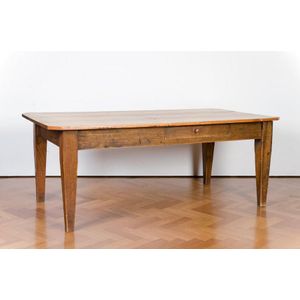Georgian inlaid mahogany fold over tea table
You must be a subscriber, and be logged in to view price and dealer details.
Subscribe Now to view actual auction price for this item
When you subscribe, you have the option of setting the currency in which to display prices to $Au, $US, $NZ or Stg.
- Mahogany - Mahogany is a dense, close grained red-coloured timber from the West Indies and Central America. It was first imported into Europe in the the early 18th century and its use continued through the 19th century. It was popular for furniture making because of its strength, the wide boards available, the distinctive grain on some boards, termed flame mahogany and the rich warm colour of the timber when it was polished.. The "flame" was produced where a limb grew out from the trunk of the tree, and this timber was usually sliced into veneers for feature panels on doors, backs and cornices.
Some terms used to describe mahogany relate to the country from which it originally came, such as "Cuban" mahogany, "Honduras" mahogany etc. However unless the wood has been tested the names assigned are more a selling feature, rather than a true indication of the timber's origin. - Inlay - Decorative patterns inserted into the main body of a piece of furniture, generally in wood of contrasting colour and grain, though brass, ivory, ebony, shell and sometimes horn have been used. Inlay may consist of a panel of well figured timber inset into a cabinet door front, geometric patterns, or complex and stylized designs of flowers, swags of foliage, fruits and other motifs. As a general rule, in pieces where the carcase is constructed in the solid, the inlay is relatively simple such as stringing, cross banding and herringbone banding. Where more elaborate and decorative work was required veneer was used. Inlay has been fashionable from at least the latter half of the 17th century, when a variety of elaborate forms were developed
- Serpentine - Resembling a serpent, in the form of an elongated 'S'. A serpentine front is similar to a bow front, except that the curve is shallow at each end, swelling towards the middle. The term presumably derives from its similarity to a moving snake or serpent. Serpentine fronts are usually veneered, with the carcase either being cut and shaped from a solid piece of timber, or built in the 'brick' method.
- Georgian - As an English stylistic period, Georgian is usually taken to cover the period from George I (1714) to the Regency of Prince George (1811-20), although the period from 1800 to 1830 is sometimes designated as the Regency period. During the Georgian period the great English cabinetmakers and designers such as Chippendale, Hepplewhite, Adam Sheraton etc., were all active.
Therefore there isn't a single 'Georgian style' as such and to say something is 'Georgian', usually means it was made between 1714 and 1830. This assumes we discount George V and George VI, both being from the 20th century.
The styles popular at the time of each reign were:
George I (1714-1727) saw out the last years of the Baroque period.
George II (1727-1760) reigned during the Rococo period.
George III (1760-1820) saw the last gasp of the Rococo, all of the early Neo-Classic 'Adam style' and most of the later neo-Classic 'Regency style'.
George IV (Prince Regent 1820-1830)encompassed the last of the 'Regency' style.
William IV's reign (1830-1837) was something of a no man's land (stylistically) and he wasn't a 'George' anyway. He covered the last glimmerings of 'Regency' and the start of the 'Victorian' style. - Foldover - A term used when describing card, tea or games tables, where the top folds over onto itself when not in use. The interior surfaces that are exposed when the top is open may be polished (in the case of tea tables) or baized (for card or games tables).
This item has been included into following indexes:
Visually similar items

A French Louis XVI style mahogany side table, with brass banding and a pair of frieze drawers supported on four tapering cylindrical legs terminating in brass caps. 67 cm high, 99 cm wide, 47 cm deep

A Regency mahogany pembroke table. Hinged sides on ring turned legs. 67 cm high, 52 cm wide, 48 cm deep. A Regency mahogany pembroke table.

Tasmanian huon pine and blackwood farm house kitchen table. Square tapering legs with a single drawer. 19th century. 204 cm 104 cm x 76 cm

Irish Regency mahogany serving table with gallery above on six ringed turned legs, 105 cm high, 176 cm wide, 55 cm deep
